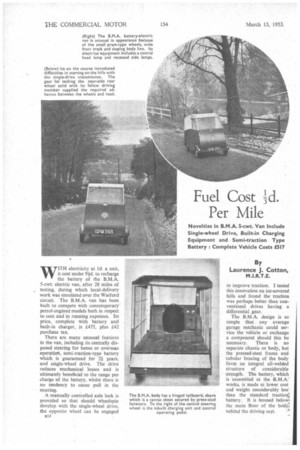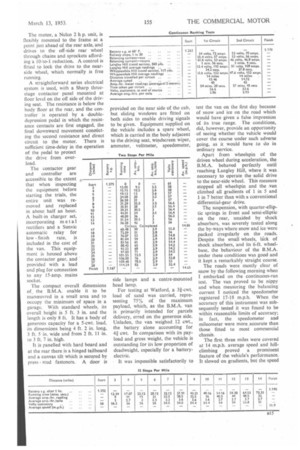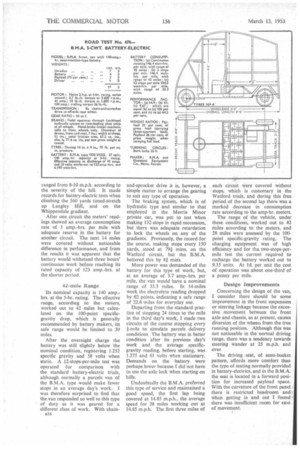Fuel Cost d.
Page 48

Page 49

Page 50

If you've noticed an error in this article please click here to report it so we can fix it.
Per Mile
Novelties in B.M.A. 5-cwt. Van Include Single-wheel Drive, Built-in Charging Equipment and Semi-traction Type Battery : Complete Vehicle Costs £517
By Laurence J. Cotton, M.1.R.T.E. WITH electricity at Id. a unit, it cost under 91d, to recharge the battery of the B.M.A. 5-cwt: electric van, after 28 miles of testing, during which local-delivery work was simulated over the Watford circuit. The B.M.A. van has been built to compete with contemporary' petrol-engined models both in respect to cost and in running expenses. Its price, complete with battery and built-in charger, is £475, plus £42 purchase tax.
There are many unusual features in the van, including its centrally disposed steering for home or overseas operation, semi-traction-type battery which is guaranteed for 21 years, and single-wheel drive. The drive reduces mechanical losses and is ultimately beneficial to the range per charge of the battery, whilst there is no tendency to cause pull in the steering.
A manually controlled axle lock is provided so that should wheelspin develop with the single-wheel drive, the opposite wheel can be engaged B14 to improve traction. I tested this innovation on ice-covered hills and found the traction was perhaps better than conventional drives having a differential gear.
The B.M.A. design is so simple that any average garage mechanic could service the vehicle or exchange a component should this be necessary. There is no separate chassis or body, but the pressed-steel frame and tubular bracing of the body form an integral all-welded structure of considerable strength. The battery, which is 'assembled at the works, is made at lower cost and weighs considerably less than the standard traction battery. It is housed below% the main floor of the boel;', behind the driving set. The motor, a Nelco 2 h p. unit, is flexibly mounted to the frame at a point just ahead of the rear axle, and drives to the off-side rear wheel through chains and sprockets affording a 10-to-1 reduction. A control is fitted to lock the drive to the nearside wheel, which normally is free running.
A straightforward series electrical system is used, with a Sharp threestage contactor panel mounted at floor level on the off side of the driving seat. The resistance is below the body floor at the rear, and the controller is operated by a double. depression pedal in which the resistance contacts are first engaged, the final downward movement connecting the second resistance and direct circuit to the motor. There is sufficient time-delay in the operation of the pedal to protect the drive from overload.
The contactor gear and controller are accessible to the extent that when inspecting the equipment before starting the trials, the entire unit was removed and replaced in about half an hour.
A built-in charger set, incorporating metal rectifiers and a Sunvic automatic relay for low finish rate, is included in the cost of the van. This equipment is housed above the contactor gear, and provided with a lead and plug for connection to any I5-amp. mains socket.
The compact overall dimensions of_ the B.M.A. enable it to be manoeuvred in a small area and to occupy the minimum of space in a garage. With standard wheels, its overall hcight is 5 ft. 3 in. and the length is only 8 ft. It has a body of generous capacity for a 5-cwt. load, its dimensions being 4 ft. 2 in. long, 3 ft. 5 in. wide and from 2 ft. 11 in. to 3 ft. 7 in. high.
It is panelled with hard board and at the rear there is a hinged tailboard and a canvas tilt which is secured by press stud fasteners. A door is
8 Ili Cr-
Start 3 4 5 6 7 8 9 10
11
12 13 14
17 18 19 20 21 22 23 24 25 26 27 28 Finish
provided on the near side of the cab, but sliding windows are fitted on both sides to enable driving signals to be given. Equipment supplied on the vehicle includes a spare wheel, which is carried in the body adjacent to the driving seat, windscreen wiper, ammeter, voltmeter, speedometer, side lamps and a centre-mounted head lamp.
For testing at Watford, a 3i-cwt. load of sand was carried, representing 75% of the maximum payload, which, as the B.M.A. van is primarily intended for parcels delivery, erred on the generous side. Unladen, the van weighed 12 cwt., the battery alone accounting for 4i cwt. In comparison with its payload and gross weight, the vehicle is outstanding fOr its low proportion of deadweight, especially for a batteryelectric.
It was impossible satisfactorily to test the van on the first day because of snow and ice on the road which would have given a false impression of its true range. The conditions, did, however, provide an opportunity of seeing whether the vehicle would cover the course under such adverse going, as it would have to do in ordinary service.
Apart from wheelspin of the driven wheel during acceleration, the B.M.A. behaved perfectly until reaching Langley Hill, where it was necessary to operate the solid drive to the near-side wheel. This measure stopped all wheelspin and the van climbed all gradients of 1 in 5 and 1 in 7 better than with a conventional differential-gear drive.
The suspension, with quarter-elliptic springs in front and semi-elliptic on the rear, unaided by shock absorbers, was severely tested along the by-ways where snow and ice were packed irregularly on the roads. Despite the small wheels, lick of shock absorbers, and its 6-ft. wheelbase, the behaviour of the B.M.A. under these conditions was good and it kept a remarkably straight course.
The roads were mostly clear of snow by the following morning when I embarked on the continuous-run test. The van proved to be nippy and when measuring the balancing current I noticed the speedometer registered 17-18 m.p.h. When the accuracy of this instrument was subsequently tested it was found to be within reasonable limits of accuracy; in fact, the speedometer and mileometer were more accurate than those fitted to most commercial chassis.
The first three miles were covered at 14 m.p.h. average speed and hillclimbing proved a prominent feature of the vehicle's performance. It slowed on gradients, but the speed ranged from 8-10 m.p.h. according to the severity of the hill. It made records for battery-electric tests when climbing the 560 yards timed-stretch up Langley Hill, and on the Whippenciale gradient.
After one circuit the meters' readings showed an average consumption rate of 3 amp.-hrs. per mile with adequate reserve in the battery for another circuit. The next 14 miles were covered without noticeable difference in performance, and from the results it was apparent that the battery would withstand three hours' continuous work before reaching its rated capacity of 123 amp.-hrs. at the shorter period.
42-mile Range
Its nominal capacity is 140 amp.hrs. at the 5-hr. rating. The effective range, according to the meters, worked out to 42 miles but calculated on the 100-point specificgravity drop, which is generally recommended by battery makers, its safe range would be limited to 30 miles.
After the overnight charge the battery was still slightly below the nominal condition, registering 1,252 specific gravity and 58 volts when static. A 12-stops-per-mile test was operated for comparison with the standard battery-electric trials, although normally a parcels van of the B.M.A. type would make fewer stops in an average day's work. I was therefore surprised to find that the van responded so well to this type of duty as it was geared for a different class of work. With chain
and-sprocket drive it is, however, a simple matter to arrange the gearing to suit any type of operation.
The braking system, which is of hydraulic type and similar to that employed in the Morris Minor private car, was put to test when making 132 stops in rapid succession, but there was adequate retardation to lock the wheels on any of the gradients. Previously, the record for the course, making stops every 150 yards, stood at 79f mins. on the Watford circuit, but the B.M.A. bettered this by 8/ mins.
More power was demanded of the battery for this type of work, but, at an average of 3.7 amp.-hrs. per mile, the van would have a nominal range of 33.3 miles. In 14-miles work the electrolyte reading dropped by 62 points, indicating a safe range of 22.6 miles for everyday use.
Departing from the standard practice of stopping 24 times to the mile in the third day's work, I made two circuits of the course stopping every i-mile to simulate parcels delivery conditions The battery was in better condition after its previous •day's work and the average specificgravity reading, before starting, was 1.275 and 61 volts when stationary. Demands on the battery were perhaps lower because I did not have to use the axle lock when starting on hills.
Undoubtedly the B.M.A. preferred this type of service and maintained a good speed, the first lap being covered at 14.85 m.p.h., the average speed for 28 miles working out at 14.65 m.p.h. The first three miles of each circuit were covered without stops, which is customary in the Watford trials, and during this free period of the second lap there was a marked decrease in consumption rate according to the amp-hr. meters.
The range of the vehicle, under these conditions, worked out to 42 miles according to the meters, and 28 miles were assessed by the 100point specific-gravity rating. The charging equipment was of high efficiency and for the two-stops-permile test the current required to recharge the battery worked out to 9.35 units. At Id. per unit the cost of operation was about one-third of a penny per mile.
Design Improvements Concerning the design of the van, I consider there should be some improvement in the front suspension or steering linkage because the excessive movement between the front axle and chassis, as at present, causes diversion of the wheeis from the true running position. Although this was not noticeable in the normal driving range, there was a tendency towards steering wander at 25 mph. and over.
The driving seat, of semi-bucket pattern, affords more comfort than the type of seating normally provided in battery-electrics, and in the B.M.A. the seat is located in a forward position for increased payload space. With the curvature of the front panel there is restricted headroom and when getting in and out I found there was insufficient room for ease of movement.




















































































